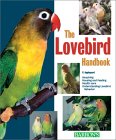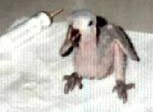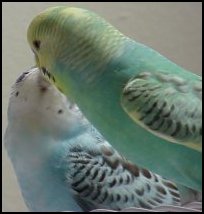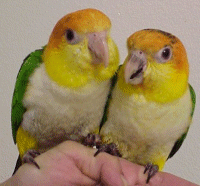We have previously discussed dangers such as nonstick cookware, zinc, junkfood, and hazardous toys and household items. One of the more critical concerns in a bird household is the presence of deadly fumes. Many fumes that would not be hazardous to humans and other pets, such as cats and dogs, can kill a bird in a few minutes. Most of these problem fumes have been discovered the “hard way.” In other words, a person used one of these items then their bird died a few minutes after exposure. In some cases, a necropsy performed by a veterinarian confirmed damage to the lungs. Continue reading »
Dangers and Risks of Hand-feeding Baby Birds
Many people have heard the myth: if you want a parrot to truly bond to you, then you should handfeed the bird yourself. Nothing could be further from the truth. More relationships between bird and human are damaged by improper hand-feeding and socialization during the early weeks of a parrot’s life. This damage is less obvious than that seen in cases of outright physical harm. Burned crops, malnutrition, pneumonia due to aspirated food, sour crop, and bacterial infections are just a few of the issues that arise when inexperienced people take on the responsibility of handfeeding a parrot. Continue reading »
Happy Hut Injury
A Happy Hut is a small tent-like item that is hung by two quick-links from the top of the cage. Birds sleep in them and sometimes sit on top of the hut. They are made of a soft material. There are number of similar sleeping huts that are marketed under different trade names.
I received a very sad e-mail today from a woman whose African Grey parrot had one of these Happy Huts and went through a terrible ordeal. Here is her story: Continue reading »
When a Bird Escapes: How to Find a Lost Bird
There is nothing quite like the feeling you get when a pet bird suddenly takes off, flying into the wild blue yonder, while you watch helplessly from the ground below. The first time this happened to me I became frantic, running around the neighborhood and calling for my one-year-old senegal parrot, Max. Max’s wings were trimmed, but they had come in enough to give him lift. The other contributing factor was that my house sat on a high hill in Los Angeles, so Max could get a considerable distance even without much lift. I could not get down the steep hill on foot, so I had to drive my car down to Sunset Boulevard to start my search. Continue reading »
Birds and Antibiotics
Many people fear antibiotics. They believe they are inherently “bad” for them and for their birds. This belief is unfortunately based on the misuse and abuse of antibiotics, and has nothing to do with their true value. Before antibiotics millions died of pneumonia and tuberculosis, as well as other infectious diseases. Antibiotics changed the faced of medicine and have significantly altered the course of humankind. They are our allies when used properly, but can create havoc when used improperly. Continue reading »
Unseen Dangers in the Home
We have previously discussed dangers such as nonstick cookware, zinc, junkfood, andhazardous toys and household items. One of the more critical concerns in a bird household is the presence of deadly fumes. Many fumes that would not be hazardous to humans and other pets, such as cats and dogs, can kill a bird in a few minutes. Most of these problem fumes have been discovered the “hard way.” In other words, a person used one of these items then their bird died a few minutes after exposure. In some cases, a necropsy performed by a veterinarian confirmed damage to the lungs. Continue reading »
Bird-Safe Holidays
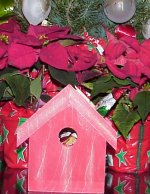 Can you find all the holiday hazards in the picture above?
Can you find all the holiday hazards in the picture above?
Pointsettias: These beautiful holiday flowering plants have a milky substance in them that is hazardous to animals and birds. If any gets on your pets, wash it off immediately, as it can cause irritation or rash, especially around the eyes, mouth, or nose areas. Obviously you do not want your birds to eat this plant, so keep them away from them at all times. It is possible to have them in your house (the display in the photo above is a centerpiece in my living room), but only when you know you can control access without fail. Continue reading »
Protect Birds from Theft
The rise in popularity of exotic birds has led to an increase in popularity of another activity: theft of exotic birds. Some large breeders have been devastated by large-scale thefts by professionals. In some states, such as Florida, the increase in bird thefts has led to major changes in how bird owners and law enforcement view this issue. There have also been some major thefts in California. Many of the breeders have had sophisticated theft protection that was evaded by criminals. Some victims have been threatened with guns. Pet stores have also been victimized, including cases where thieves smash store windows and grab birds. While this might seem to be a concern only of breeders and pet store owners, thefts of pet birds from homes have been on the increase as well. All owners of pet birds should consider taking precautions to prevent the loss of their beloved pets. Continue reading »
The State of Avian Veterinary Research
Report from The American Federation of Aviculture Meeting
Lecturer: Darrell Styles, DVM
Department of Veterinary Pathobiology
The Schubot Exotic Bird Health Center
Texas A & M University
The Schobot Exotic Bird Health Center is one of the top research facilities in the United States where the study of exotic species, particularly large parrots and endangered birds, is the main focus of research. Dr. Darrell Styles, a lecturer in the Department of Veterinary Pathobiology, spoke at the most recent meeting of the American Federation of Aviculture. His lecture was very interesting, and will give you a good idea as to the current issues facing researchers in the field of avian medicine. This is the first in a multi-part series on the current status of avian research. Continue reading »
Cats and Birds
Guinevere is a typical cat. She patrols her yard and keeps other cats at bay. She chases wild birds in the yard. She hunts at night. Guinevere followed her instincts, the way most animals do. The question I had was: Could I live in the back house behind the home where Guinevere reigned supreme and not spend half my time wondering if she was terrorizing my birds? Eventually my question was answered: Guinevere was an exceptional cat, and she quickly learned that these birds were pets and she was not to mess with them. My experience taught me that SOME cats do have the ability to live in relative harmony with pet birds. Other experiences (a neighborhood cat that had to be chased off with a hose at 2 am on a few occasions) showed me that some cats are ruled by their instincts and will never be appropriate in the same home as pet birds. Continue reading »

